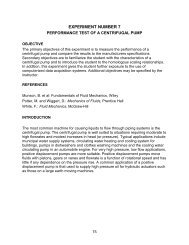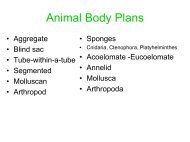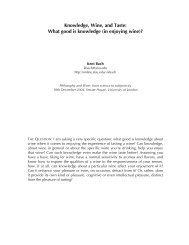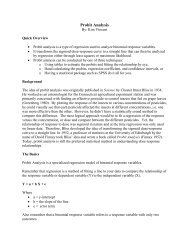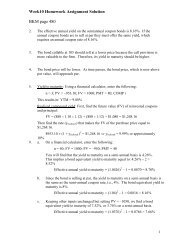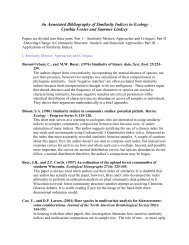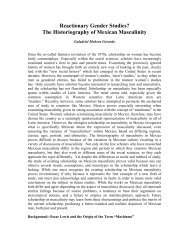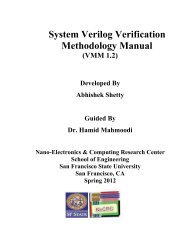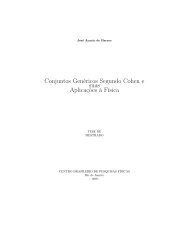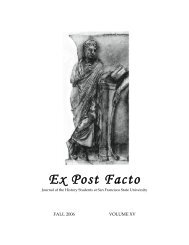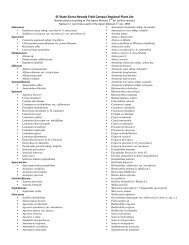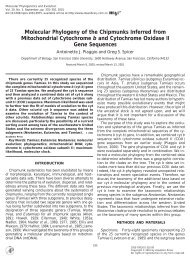Biol 529 Plant Ecology Similarity among communities Communities ...
Biol 529 Plant Ecology Similarity among communities Communities ...
Biol 529 Plant Ecology Similarity among communities Communities ...
Create successful ePaper yourself
Turn your PDF publications into a flip-book with our unique Google optimized e-Paper software.
index, the “minimum” value (# individuals or %cover or Importance Value) for a species when comparing two <br />
samples is used for the numerator values. <br />
Ecologists often use different names to describe the same index. For example, Pielou’s percentage <br />
similarity is the same as Bray-‐Curtis, Sorensen’s quantitative index and the Czekanowski’s quantitative <br />
index (but there is disagreement about this latter case). <br />
Lab Problems: <br />
We will use a made-‐up data set to compare the performance of these similarity indices. Imagine comparing <br />
two <strong>communities</strong> (samples) with 30 species each and 25 species are found in both samples. Run your <br />
calculations. Then modify the proportions in the two samples so you can understand how the indices <br />
perform. Change the proportions so both samples keep 30 species, but only 20 are in common, then 15, then <br />
10, then 5. Then contrast a 30 species community with a 20 species community (start with 20 species in <br />
common), and make similar proportion shifts. <br />
Now let’s see how the total number of species influences things. Start with comparing a two <strong>communities</strong> of <br />
30 species with 20 species in common (you did this above). Now change it so they both have 30 species, but <br />
only 19 in common. Now compare two <strong>communities</strong> of 15 species each with 10 species in common, and then <br />
with 9 species in common. Finally, compare two <strong>communities</strong> of 3 species each, with 2 species in common, <br />
then change it to 1 species in common. In this second round, we’re only shifting 1 species each time, but <br />
because of ‘proportion’ shifts, the measures perform quite differently. If we were using Bray-‐Curtis values, <br />
the shifts may not have changed in the same manner. <br />
Assignment: Take the Sierran data and calculate similarities between one elevation and that above or below <br />
it. <br />
1. Create an ‘average IV matrix’ for each species for each elevation. <br />
2. Create a presence-‐absence matrix as well. <br />
3. Calculate a Jaccard Index for 7000 & 6500, 6500 & 6000, 6000 & 5500, etc. Do the same for Sorensen’s and <br />
Bray-‐Curtis Index. <br />
4. Create a graph for each index. Plot the Index value on the Y-‐axis. For the X-‐axis, use the ‘joint’ elevation <br />
value. <br />
5. Examine the graphs. In a paragraph or two, discuss whether these similarity indices suggest whether <br />
there are one, two, three or more plant <strong>communities</strong> along the elevation gradient. In other words, is there a <br />
significant change in the value of the indices such that one elevation is much more different (less similar) to <br />
the next elevation than is typical for the other elevation pairs? <br />
6. You can work in groups to do the calculations and discuss them, but write the paragraph by yourself. <br />
7. Turn in the graphs you make along with the discussion.



